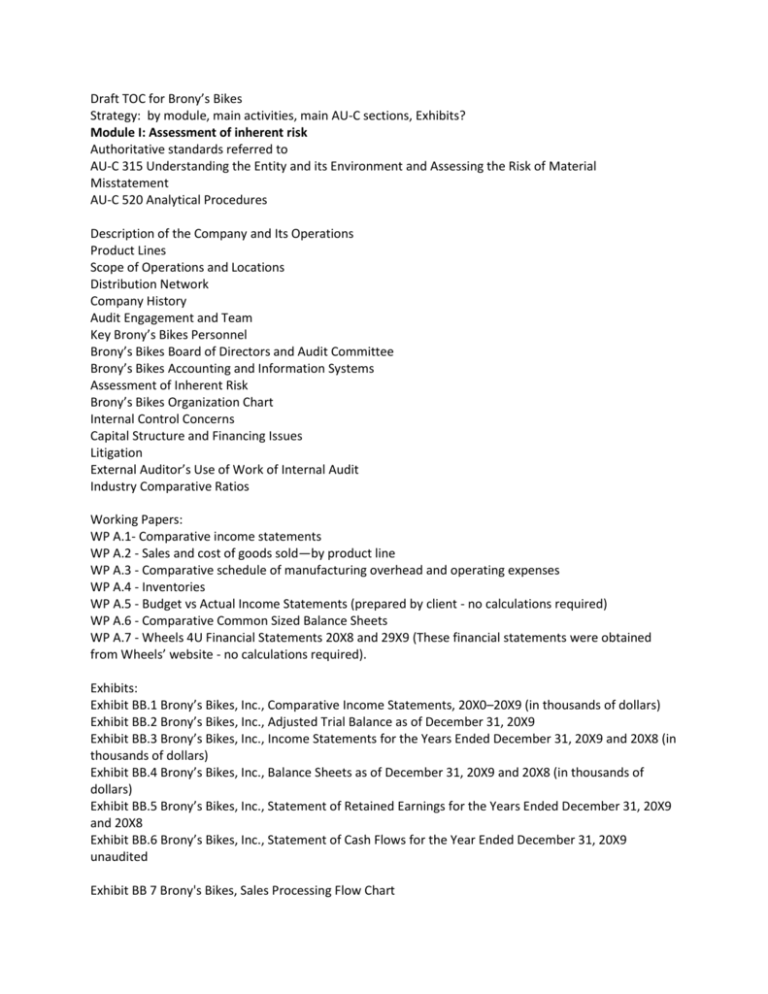1305080572_490665
advertisement

Draft TOC for Brony’s Bikes Strategy: by module, main activities, main AU-C sections, Exhibits? Module I: Assessment of inherent risk Authoritative standards referred to AU-C 315 Understanding the Entity and its Environment and Assessing the Risk of Material Misstatement AU-C 520 Analytical Procedures Description of the Company and Its Operations Product Lines Scope of Operations and Locations Distribution Network Company History Audit Engagement and Team Key Brony’s Bikes Personnel Brony’s Bikes Board of Directors and Audit Committee Brony’s Bikes Accounting and Information Systems Assessment of Inherent Risk Brony’s Bikes Organization Chart Internal Control Concerns Capital Structure and Financing Issues Litigation External Auditor’s Use of Work of Internal Audit Industry Comparative Ratios Working Papers: WP A.1- Comparative income statements WP A.2 - Sales and cost of goods sold—by product line WP A.3 - Comparative schedule of manufacturing overhead and operating expenses WP A.4 - Inventories WP A.5 - Budget vs Actual Income Statements (prepared by client - no calculations required) WP A.6 - Comparative Common Sized Balance Sheets WP A.7 - Wheels 4U Financial Statements 20X8 and 29X9 (These financial statements were obtained from Wheels’ website - no calculations required). Exhibits: Exhibit BB.1 Brony’s Bikes, Inc., Comparative Income Statements, 20X0–20X9 (in thousands of dollars) Exhibit BB.2 Brony’s Bikes, Inc., Adjusted Trial Balance as of December 31, 20X9 Exhibit BB.3 Brony’s Bikes, Inc., Income Statements for the Years Ended December 31, 20X9 and 20X8 (in thousands of dollars) Exhibit BB.4 Brony’s Bikes, Inc., Balance Sheets as of December 31, 20X9 and 20X8 (in thousands of dollars) Exhibit BB.5 Brony’s Bikes, Inc., Statement of Retained Earnings for the Years Ended December 31, 20X9 and 20X8 Exhibit BB.6 Brony’s Bikes, Inc., Statement of Cash Flows for the Year Ended December 31, 20X9 unaudited Exhibit BB 7 Brony's Bikes, Sales Processing Flow Chart Exhibit BB.8 Brony's Bikes, Processing Flowchart—Cash Receipts from Customers Exhibit BB.9 Brony's Bikes Purchases and Accounts Payable Flowchart Exhibit BB.10 Brony's Bikes, Payment Processing Flowchart Exhibit BB.11 Brony's Bikes, Processing Payroll Processing Flowchart Exhibit BB 12 Brony’s Bikes, Selected Client Adjusting Entries, December 31, 20X9 Exhibit BB 13 Brony’s Bikes, Vouchers Register partial, December 31, 20X9 Exhibit BB 14 Brony's Bikes, Sales Summary, December 31, 20X9 Exhibit BB 15 Brony’s Bikes, Cash Summary, December 31, 20X9 Exhibit BB 16 Brony's Bikes, Check Register partial, December 31, 20X9 Procedures: Prepare a complete organization chart for Brony’s Bikes Prepare a common-sized income statement Prepare a common-sized cost per unit calculation as a percentage of sales price Prepare a common-sized components calculations as a percentage of sales Calculate finished goods inventory turnover Calculate materials and purchased parts turnover Compare budget to actual income statement amounts for variances of interest to the auditor Complete a common sized balance sheet Calculate current ratio, quick ratio, times interest earned, and return on stockholders’ equity Compare current ratio, quick ratio, times interest earned, and return on stockholders’ equity with industry averages Compare common sized financial statements and related ratios with peer company, Wheels 4U Identify strengths and weaknesses of Brony's Bikes with peer company, Wheels 4U Based on your analytical procedures performed identify concerns that inspire further testing. Relate your concerns to management’s assertions contained in the financial statements (existence or occurrence, completeness, valuation or allocation, rights and obligations, and presentation and disclosure.) Identify any specific transaction areas for which you are you willing to reduce inherent risk below 100% Module II: Assessment of control risk Authoritative standards referred to AU-C 200 Overall Objectives of the Independent Auditor and the Conduct of an Audit in Accordance With Generally Accepted Auditing Standards Committee of Sponsoring Organizations (COSO) Executive Summary Description of the Accounting Information System and Internal Control over Financial Reporting Computerized Ledger Sales Processing Cash Receipts from Customers Purchases and Accounts Payable Processing Payment Processing Production Payroll Processing Other Accounting System Features Procedures Identify and assess weaknesses in the internal control over financial reporting by reference to specific assertions Develop a list of questions that you would want to ask management so that you could gain enough information to make those assessments Identify any specific transaction areas are you willing to assess control risk less than high (100%) Module III: Control testing the sales processing subset of the revenue cycle Working Papers: WP C Sampling Plan Other matters Risk of Overreliance Tolerable Failure (Deviation) Rate Misstatements Detected Revenue Cycle Procedures Based on the deficiencies in the design of controls identified in the sales processing subset of the revenue cycle as explained in the first two paragraphs of this module, assess whether or not the sampling and testing plan address all relevant financial statement assertions related to sales and accounts receivable Complete the attribute sampling plan worksheet Assess the impact on further testing as a result of the identified misstatements in the revenue cycle Assess whether or not the aggregate materiality threshold be changed for any part of the revenue cycle Module IV: PPS sampling—factory equipment additions Monetary Unit Sampling (MUS) Stratifying the Sample Define the Population Basic precision Incremental allowance for sampling error Upper misstatement limit Excel file 20X9 MUS WP 11.3A—Monetary unit sampling plan; WP 11.3B—Monetary unit sampling plan—projected misstatement; and WP 11.3C—Monetary unit sampling plan—computed precision and upper misstatement limit. Risk of incorrect acceptance Procedures Determine the objective of performing the test of factory equipment expenditures, the relevant population, and the sampling unit Calculate the sampling interval Evaluate the risk of incorrect acceptance, expected population deviation rate, and the tolerable rate of deviation Assess the tainting percentage Schedule out the projected misstatements Evaluate the sampling results and recommend any further work you deem to be necessary based on those results Module V: Accounts receivable aging analysis and adequacy of allowance for doubtful accounts Excel file 20X9 AR WP 3—Accounts and notes receivable—trade WP 3.A—Accounts receivable aging analysis WP 3.C—Allowance for uncollectible accounts Other matters Audit Confirmations Reclassification Entry Quality of Audit Evidence Procedures Evaluate sampling results for receivables Determine whether further procedures are required as the result of positive confirmations not returned Evaluate whether or not subsequent collections of receivable should be tested Examine evidence supporting or not supporting the write-off of receivables amounts Assess the sufficiency of the allowance for doubtful accounts Module VI: Sales and purchases cutoff tests Authoritative standards AU-C 501 Audit Evidence—Specific Considerations for Selected Items Other matters Cutoff Test Voucher Register Sales Summary Inventory Observation Excel file 20X9 Cutoff Audit Adjustments Intentional versus Unintentional Misstatements WP 6.4 Inventory Cutoff Procedures Compare cutoff results with the voucher register and sales summary Draft any audit adjustments suggested by the cutoff analysis performed Module VII: Search for unrecorded liabilities Excel file 20X9 Liab WP 15.1 Other matters Unrecorded Liabilities Procedures Assess the adequacy of the procedures performed on unrecorded liabilities Assess the materiality of unrecorded liabilities detected Module VIII: Dallas Dollar Bank—bank reconciliation Excel file 20X9 Bank WP 1.A - Cash on hand and in banks WP 1.B - Bank reconciliation—Dallas Dollar Bank WP 1.C - Inter-bank transfer schedule Other matters Bank Reconciliation Deposit in transit Bank Cutoff Statement Outstanding Checks Procedures Determine whether the Dallas Dollar Bank reconciles to WP 1.B Assess the cause of any non reconciling items Draft the necessary audit adjustment in response to a check that was recorded in an incorrect amount Inspect the bank cutoff statement for items relevant to December 31 balances Assess whether there are bank transfer issues Module IX: Analysis of inter-bank transfers WP 1.C - Inter-bank transfer schedule Other matters Inter-bank Transfer Schedule Procedures Examine evidence related to the $3 million loan to officer (Lawton) Assess whether or not the loan was repaid as of December 31 as reported Draft any required reclassification entry Examine the covenants for any loans from either Brony’s Bikes bank determine whether any covenants were or are in violation resulting is possible default Recommend any additional audit procedures you think are necessary as relates to the status of the loan to officer Lawton Module X: Analysis of marketable securities Excel file 20X9 Security WP 2 Other matters Marketable Securities Loss on Decline of Market Value of Securities Allowance for Decline of Market Value of Securities Procedures Assess the consistency of Brony’s Bikes security investment objective with its present portfolio composition Determine whether the securities with this portfolio are correctly classified as current or non current Examine WP 2 and compare the composition of the securities portfolio with Brony’s Bikes stated objectives Draft appropriate language in WP 2 legend explaining how market values have been determined Draft proposed adjustment for correction of fair values Draft proposed adjustment for correction of interest revenue Module XI: Plant asset additions and disposals Excel file 20X9 Plant Excel files 20X9 MUS WP 11—Plant assets and accumulated depreciation WP 11.4 - Factory equipment - additions and disposals Other matters Additions and Disposals Salvage Value Half-year Depreciation (convention) Procedures Post required audit adjustment (s) from WP 11 to the appropriate lead schedule Examine the underlying documentation referred to in the explanation of audit legends E and W Assess the relevance and reliability of the underlying documentation for WP 11 Evaluate the misstatement of gain on disposal and propose an appropriate audit adjustment Propose an appropriate audit adjustment in response to the incorrect depreciation entry arising from the misstatement of gain on disposal Assess whether the half year depreciation convention has been appropriately applied Assess whether the depreciation misstatement is carried over to next year’s overhead allocation and propose correction of this misstatement does affect next year’s overhead allocation Post audit adjustments #10 and 11 in WP 11 Module XII: Estimated liability for product warranty Excel file 20X9 Warranty WP 20 Other matters Estimated Liability for Product Warranty Procedures Examine the WP 20 carefully and comment on its adequacy and completeness Draft any appropriate adjusting entry in response to your examination of the estimated liability for product warranty Determine whether your examination would indicate a retrospective adjustment through retained earnings or a prospective adjustment through current and future statements of income Module XIII: Mortgage note payable and note payable to Bank Two Excel file 20X9 Notes WP 14 - Notes payable and accrued interest - lead schedule; and WP 14.3 - Notes payable—long-term Other matters Mortgage Note Payable Procedures Determine the audit objectives in the examination of WP 14.3 long-term notes payable Determine the most relevant assertions to be tested in WP 14.3 Based on WP 14.3 determine whether the relevant assertions have been appropriately tested Determine whether WP 14.3 documentation satisfies the stated audit objectives for long-term notes payable Record Reclassification Journal Entry C for the current portion of both notes Determine the nature of the adjustment to “notes payable - trade” and to “interest payable” appearing in the adjustments column of the lead schedule Module XIV: Working trial balance Authoritative standards AU-C 500 Audit Evidence AU-C 520 Analytical Procedures Working Trial Balance Excel file 20X9AJE sol Excel file 20X9 WTB Excel file 20X9 AUDBS WP A.5 Budgeted Versus Actual Income Statements Other matters Substantive Audit Testing Auditor’s Opinion Disclaimer Materiality Understatements and Overstatements Ratios Budgeted Balances Audited Balances Variances Evaluating Audit Evidence Procedures Perform the review phase analytical procedures Compare the two materiality thresholds provided with the proposed audit adjustments Determine whether either or both of the materiality thresholds have been exceed Draft language for the appropriate WP that clearly states the impact on the auditor’s report if Brony’s Bikes does not agree to make the proposed audit adjustments, either in total or in part Calculate the percentages of individual balance sheet items and components relative to totals for 20X9 Calculate the new ratios for 20X9 based on the audited financial statements Prepare a comment to WTB stating the purpose of applying analytical procedures in the evaluation and review phase of the audit Prepare a comment to WTB stating the audit significance if the auditor fails to develop independent expectations as part of performing final analytical procedures Compare audited balance sheets together with the related ratios with the balance sheets and ratios that you developed in Module I and document the conclusions can you draw regarding the comparison Copy WP A.5 into the new file substituting the audited amounts for unaudited amounts but retaining the budgeted amounts Determine whether unexpected changes have occurred in the WP A.5 comparison Module XV: Audit report Authoritative standards AU-C 260 The Auditor’s Communication With Those Charged With Governance AU-C 265 Communicating Internal Control Related Matters Identified in an Audit AU-C 501 Audit Evidence—Specific Considerations for Selected Items (litigation) AU-C 570 The Auditor’s Consideration of an Entity’s Ability to Continue as a Going Concern AU-C 580 Written Representations AU-C 700 Forming an Opinion and Reporting on Financial Statements AU-C 705 Modifications to the Opinion in the Independent Auditor’s Report AU-C 706 Emphasis-of-Matter Paragraphs and Other-Matter Paragraphs in the Independent Auditor’s Report Other matters Audit Report Footnote Disclosures Representation Letter Significant Deficiencies Internal Control Deficiencies Legal Action Liquidity Problems Loan Default Substantial Doubt as to Continued Existence (Going Concern) Procedures Review the narrative included in Module XV and document any matters discussed with management or revealed in the various written representations for which you feel that further audit work is necessary before deciding on the final language of the auditor’s report Prepare any comments you have on the appropriateness of the proposed auditor’s report








